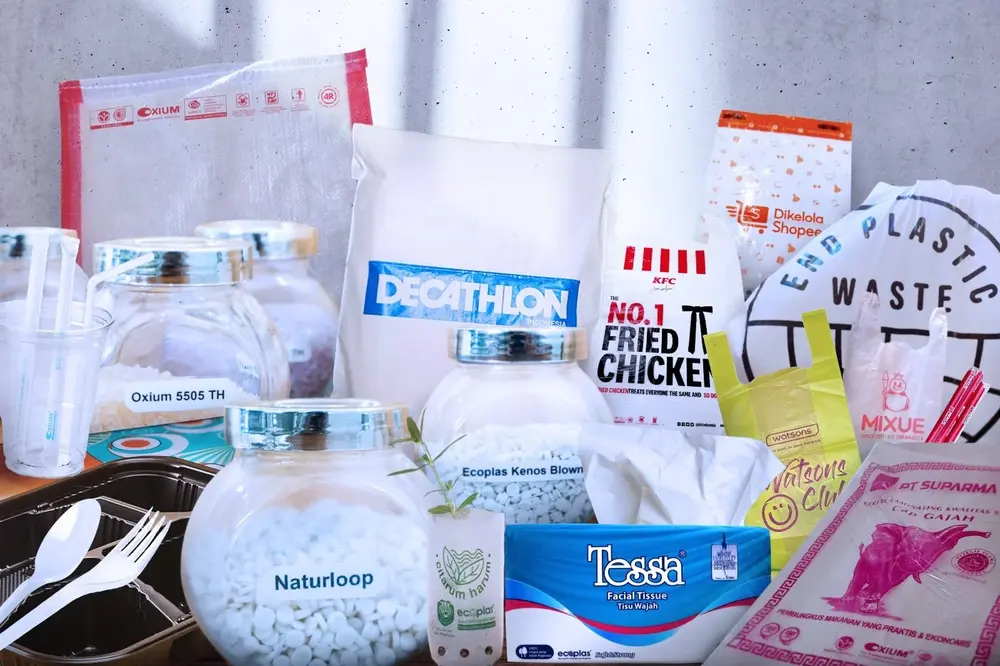Bioplastic Biodegradable vs Bioplastic Compostable: What is the Difference ?
Monday, 18 September 2023
The single-use plastic bags that you throw away accumulate in the land and ocean. Therefore, there are various types of bioplastic alternatives created to solve this problem.
Biodegradable bioplastics are a type of plastic that can decompose faster in nature with the help of oxygen, heat, microbes and other natural factors. Among the commonly used bioplastics is Oxium, this biodegradable technology can break down to molecules in just three to five years.
What is Biodegradable Bioplastic?
Biodegradable bioplastics can be made from biobased and petroleum-based raw materials or catalysts consisting of mineral salts. Metals allow the molecular structure of the plastic to break down when exposed to heat and oxygen.
Bioplastic materials will degrade when they reach conditions where microorganisms can process them. This situation shortens the degradation process from centuries to months or years. The presence of microorganism activity will accelerate the degradation process. This gives it a distinct advantage over other methods of degrading plastics. The degradation time itself varies, which is influenced by natural conditions such as sunlight, heat and microorganism conditions.
If used properly, this type of bioplastic will not last for years, but will degrade within 6 to 35 months.
Life cycle of Biodegradable Bioplastics
Once produced, biodegradable bioplastics will be applied in various packages or bags. After use and end of life, biodegradable bioplastics will decompose in nature.
Biodegradation has two stages of decomposition process. The first stage starts with the "abiotic degradation" phase. The purpose of this first phase is to physically reduce the molecular chain of the polymer so that microorganisms can decompose it. This phase heavily involves physical factors. The abiotic phase is influenced by UV light, temperature or oxygen in the landfill. These physical factors can break the molecular chains of biodegradable bioplastics.
The second stage is the biotic phase. At this stage, microorganisms play a big role in the process of decomposing biodegradable plastics. This bioplastic decomposition activity by microorganisms can produce H2O, CH4, CO2 and biomass. The decomposition products can then be utilized further, CH4 for example can be used as a new energy source.
Biodegradable vs Compostable
Biodegradability is the ability to decompose plastic by microorganisms that are abundant in nature under certain conditions and it is eventually converted into carbon dioxide and water. Depending on the degradation environment, biodegradability can be further divided into industrial compostable, household compostable, biodegradable in soil, and biodegradable in marine waters.
Actually, compostable is a subset of biodegradable. Biodegradable polymers or biodegradable plastics refer to polymeric materials capable of undergoing decomposition into carbon dioxide, methane, water, inorganic compounds, or biomass in which the predominant mechanism is the enzymatic action of microorganisms, which can be measured by standardized tests, within a specified period of time, reflecting the
available final disposal conditions (e.g. ASTM D6813 or ASTM 5338 standards). Some biodegradable plastics can also be made compostable with specific reference to their biodegradation in a compost system at either household or industrial scale, and this indicates that this type of bioplastic is capable of biological decomposition in a compost site or system.
Both are not easy to distinguish visually, but still decompose into carbon dioxide, water, inorganic compounds and biomass. Standard testing is generally done to determine compostable and bioplastic materials through the ASTM D6400 standard. Compostable plastic products are usually heavily processed or will end up going through industrial-scale composting with a process length of usually 12 weeks in the high temperature phase above 50°C and must meet good quality criteria such as heavy metal content, ecotoxicity and lack of clearly distinguishable polymer residues. There are also compostable plastics that can be processed or composted at the household scale, so that after this type of bioplastic is used, it can be incorporated into household composting systems such as takakura.
Greenhope Develops Biodegradable and Compostable Bioplastics
Biodegradable and compostable plastics both claim that the biodegradation cycle will convert the plastic into carbon dioxide, water, and biomass.
The biodegradation time period is different. Compostable plastics degrade within two to six months in industrial compost. Biodegradable, on the other hand, will degrade over a period of up to 3 to 5 years in an open environment.
In both cases, microorganisms consume the plastic and inhale carbon dioxide. Compostable plastic degradation releases carbon dioxide in the environment much faster than Biodegradable. Biodegradable releases carbon dioxide much more slowly.
Eventually, the bacteria die, and the resulting biomass is the "corpse" of the microorganisms. Compostable plastics call this biomass "compost". However, Biodegradable does not claim to produce compost.
Greenhope has two eco-friendly plastic options.
Oxium - Biodegradable plastic
Naturloop - compostable
Both are made as a solution to the plastic waste issue that has become a worldwide problem. Oxium is a biodegradable plastic with a mixture of additives while Naturloop is a compostable plastic made from cassava starch.
No need to worry! Both still have the superior properties of strong and waterproof plastic. However, each can degrade faster when wasted on land or leaking into the ocean. Both types of Greenhope plastics already have the appropriate patents and certifications so they are safe and you can use them anytime.



